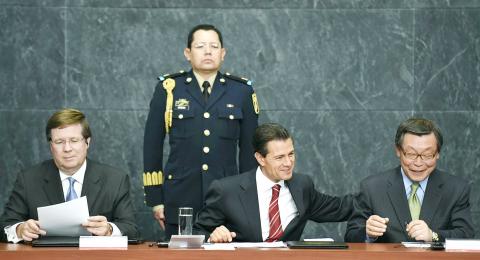Toyota Motor Corp plans to build new auto assembly plants in Mexico and China, ending a self-imposed three-year break from expansion over quality concerns due to massive recalls.
Toyota on Wednesday said it would invest US$1 billion in the plant in the Mexican state of Guanajuato, creating 2,000 jobs to make the Corolla compact car, the firm’s second-biggest seller in the US.
Production is to start in 2019, with annual output estimated at 200,000 vehicles. That will consolidate Corolla production for North America in that plant and Toyota’s plant in Blue Springs, Mississippi.

Photo: AFP
Toyota will stop producing Corollas at its plant in Ontario, Canada, which will instead focus on more expensive mid-size vehicles. Toyota did not give specifics. The plant now produces Lexus models, the RAV4 sport-utility vehicle and the Matrix hatchback, in addition to the Corolla.
Toyota is adding a third assembly line next to its plant in Guangzhou, China, investing ¥52.5 billion (US$440 million). The line is to be completed by 2017, for a model it declined to disclose.
Annual production capacity will go up by 100,000 vehicles. The new line will not create new jobs because the existing two lines will become more efficient, reducing the number of workers needed, according to Toyota.
A Toyota executive, briefing reporters in Tokyo over a video connection from Nagoya, Japan, said Mexico and China were chosen because they are two markets where auto demand is expected to rise in coming years.
Toyota’s investment in Mexico follows a string of major projects by other automakers, and Mexican President Enrique Pena Nieto said it shows the country is as an “optimal place for global companies to invest and thereby expand their presence in the entire world.”
Ford Motor Co is today expected to announce a US$2.5 billion investment to expand Mexican engine and transmission factories to build a new 1.5 liter four-cylinder gasoline engine and complex multi-speed transmissions.
Pena Nieto said Mexico’s advantages include qualified workers and good labor relations.

Taiwanese suppliers to Taiwan Semiconductor Manufacturing Co. (TSMC, 台積電) are expected to follow the contract chipmaker’s step to invest in the US, but their relocation may be seven to eight years away, Minister of Economic Affairs J.W. Kuo (郭智輝) said yesterday. When asked by opposition Chinese Nationalist Party (KMT) Legislator Niu Hsu-ting (牛煦庭) in the legislature about growing concerns that TSMC’s huge investments in the US will prompt its suppliers to follow suit, Kuo said based on the chipmaker’s current limited production volume, it is unlikely to lead its supply chain to go there for now. “Unless TSMC completes its planned six

Intel Corp has named Tasha Chuang (莊蓓瑜) to lead Intel Taiwan in a bid to reinforce relations between the company and its Taiwanese partners. The appointment of Chuang as general manager for Intel Taiwan takes effect on Thursday, the firm said in a statement yesterday. Chuang is to lead her team in Taiwan to pursue product development and sales growth in an effort to reinforce the company’s ties with its partners and clients, Intel said. Chuang was previously in charge of managing Intel’s ties with leading Taiwanese PC brand Asustek Computer Inc (華碩), which included helping Asustek strengthen its global businesses, the company

Power supply and electronic components maker Delta Electronics Inc (台達電) yesterday said second-quarter revenue is expected to surpass the first quarter, which rose 30 percent year-on-year to NT$118.92 billion (US$3.71 billion). Revenue this quarter is likely to grow, as US clients have front-loaded orders ahead of US President Donald Trump’s planned tariffs on Taiwanese goods, Delta chairman Ping Cheng (鄭平) said at an earnings conference in Taipei, referring to the 90-day pause in tariff implementation Trump announced on April 9. While situations in the third and fourth quarters remain unclear, “We will not halt our long-term deployments and do not plan to

The New Taiwan dollar and Taiwanese stocks surged on signs that trade tensions between the world’s top two economies might start easing and as US tech earnings boosted the outlook of the nation’s semiconductor exports. The NT dollar strengthened as much as 3.8 percent versus the US dollar to 30.815, the biggest intraday gain since January 2011, closing at NT$31.064. The benchmark TAIEX jumped 2.73 percent to outperform the region’s equity gauges. Outlook for global trade improved after China said it is assessing possible trade talks with the US, providing a boost for the nation’s currency and shares. As the NT dollar